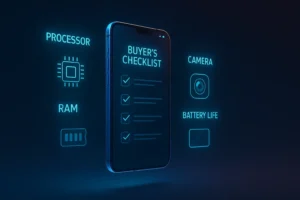Introduction: Why Choosing the Right Motherboard Matters
When building or buying a computer, many consumers put their focus on the CPU, graphics card, or RAM. However, the motherboard is the foundation of the entire system. A wrong choice here can bottleneck performance, restrict upgrades, and even cause hardware incompatibility issues.
This guide is designed for everyone — whether you’re a gamer, content creator, office worker, student, or even a server manager.
By the end of this article, you will have enough understanding to choose the best motherboard tailored to your specific needs.
What Exactly is a Motherboard?
The motherboard is a printed circuit board (PCB) that connects all the hardware components of your computer. It allows communication between the CPU, RAM, GPU, storage devices, and peripherals.
Main Functions:
- Houses the CPU socket.
- Provides RAM slots.
- Connects GPUs and expansion cards.
- Links storage drives (SSD/HDD).
- Powers USB devices, networking, and audio.
- Coordinates data communication between components.
Key takeaway:
The motherboard determines what hardware you can use and how well they work together.
Different Types of Motherboards
Before selecting, understand the common form factors:
| Form Factor | Size | Usage |
|---|---|---|
| ATX | 12″ x 9.6″ | Full-sized desktops; most common for gamers and professionals. |
| Micro-ATX (mATX) | 9.6″ x 9.6″ | Slightly smaller, fits in compact cases. |
| Mini-ITX | 6.7″ x 6.7″ | For very small builds, home theater PCs (HTPCs). |
| E-ATX | 12″ x 13″ | For workstation builds and enthusiast rigs (multiple GPUs). |
🔹 Important Tip:
Make sure the case you choose supports your motherboard’s size.
Core Components to Check
To choose wisely, you must understand these motherboard components:
3.1 CPU Socket
The socket is where the processor (CPU) is installed.
- Intel CPUs (2025): Use sockets like LGA 1700 (12th–14th gen) or newer.
- AMD CPUs: Use AM5 (Ryzen 7000 series and newer).
🔹 Tip:
Always match the CPU with the correct socket! Otherwise, the CPU simply won’t fit.
3.2 Chipset
The chipset controls data flow and features. It defines:
- Number of USB ports.
- PCIe lanes (for GPUs, storage).
- Overclocking capability.
- RAM speed support.
Intel Chipsets (example):
- Z790: High-end; supports overclocking.
- B760: Mid-range; good for most users.
- H610: Budget; basic features.
AMD Chipsets (example):
- X670E: Enthusiast grade.
- B650: Mainstream.
- A620: Budget builds.
🔹 Tip:
High-end chipsets are future-proof but costlier.
3.3 RAM Slots and Support
- DIMM Slots: 2 slots (small boards) or 4 slots (standard ATX).
- Supported RAM Types: DDR4 or DDR5.
- Maximum Supported Speed: Important for performance.
🔹 Tip:
If you plan heavy multitasking, pick a board with 4 slots and support for higher capacity RAM (e.g., 128 GB).
3.4 Expansion Slots (PCIe)
Expansion slots allow you to add:
- Graphics cards.
- NVMe SSD cards.
- Capture cards.
- Wi-Fi adapters.
- PCIe 4.0: Standard for 2023–2025 systems.
- PCIe 5.0: Emerging, ultra-fast for GPUs and SSDs.
🔹 Tip:
At least one PCIe x16 slot is needed for a GPU.
3.5 Storage Interfaces
- SATA Ports: For 2.5″ SSDs and HDDs.
- M.2 Slots: For NVMe SSDs (ultrafast storage).
- PCIe Storage: For extreme performance builds.
🔹 Tip:
More M.2 slots = better storage options in future.
3.6 Connectivity Ports
- USB 3.2 Gen2: Faster data transfer.
- USB Type-C: Modern connectivity.
- Thunderbolt 4: Premium motherboards (external GPUs, docking stations).
🔹 Tip:
Pick based on what devices you often plug into your PC.
3.7 Network and Wi-Fi Support
- 1 Gbps Ethernet: Basic standard.
- 2.5G Ethernet: Great for gamers and heavy network users.
- Wi-Fi 6E or Wi-Fi 7: Latest wireless standards.
🔹 Tip:
If you use Wi-Fi, a board with integrated Wi-Fi is highly recommended.
3.8 Audio System
- Basic audio: Sufficient for casual users.
- High-end audio codecs (e.g., Realtek ALC4080): Needed for music producers, gamers, or content creators.
Defining Your Use Case
Matching motherboard features to your needs:
| Use Case | Motherboard Requirement |
|---|---|
| Gaming | High-speed PCIe lanes, decent VRMs, good cooling. |
| Content Creation | More RAM support, fast storage, strong CPU VRMs. |
| Office Work | Budget board, reliable connectivity. |
| Home Server | High storage ports, network stability. |
| Enthusiasts | Overclocking, advanced cooling, premium audio, multiple GPUs. |
🔹 Tip:
Never overspend on features you won’t use.
Special Features Explained
- Overclocking Support: Boosting CPU/RAM speeds beyond official specs.
- BIOS Flashback: Update BIOS without CPU installed — handy for future CPU upgrades.
- Q-Code LED Display: Displays error codes for easy troubleshooting.
- Reinforced PCIe Slots: Protects GPU from sagging damage.
- Onboard Power/Reset Buttons: Useful for open-bench setups.
Understanding VRMs and Power Delivery
VRM stands for Voltage Regulator Module. It ensures the CPU gets clean, stable power.
Good VRMs = better CPU stability, cooler temperatures, higher overclocking headroom.
Tip:
If buying powerful CPUs like i9, Ryzen 9, Threadripper, ensure strong VRM cooling.
Budgeting Smartly
Motherboard prices can vary:
- Budget Range: $80–$150
- Mid-Range: $150–$300
- High-End/Enthusiast: $300–$800+
🔹 Golden Rule:
Spend 20–25% of your total PC budget on the motherboard.
Future-Proofing
- Choose boards with PCIe 5.0 support if keeping the PC for 5+ years.
- Opt for boards with 2.5G Ethernet or Wi-Fi 6E/7.
- Pick boards supporting DDR5 RAM.
Common Mistakes to Avoid
- Mistake 1: Buying a high-end motherboard with a weak CPU.
- Mistake 2: Ignoring future storage/expansion needs.
- Mistake 3: Buying a non-overclocking board for an unlocked CPU.
- Mistake 4: Buying a board that doesn’t fit your case.
Motherboard Brands Overview
| Brand | Reputation |
|---|---|
| ASUS | Premium features, best BIOS. |
| MSI | Great gaming boards, sturdy build. |
| Gigabyte | Value for money, good VRMs. |
| ASRock | Budget friendly, feature-rich. |
Before buying:
We recommend checking out our constantly updated Top Lists Which are designed to match your budget, system goals, and future plans — making sure you pick the right motherboard every time!
Sample Best Choices for 2025
| Use Case | Recommended Board |
|---|---|
| Gaming PC | ASUS ROG Strix Z790-F |
| Budget Gaming | MSI B760 Tomahawk |
| Content Creator | Gigabyte X670 AORUS Master |
| Home Office | ASRock B650M Pro RS |
| Enthusiast Build | ASUS Maximus Z790 Extreme |
Conclusion: Your Personal Checklist Before Buying
Before finalizing your motherboard:
- ✅ Match the CPU socket.
- ✅ Choose the right chipset.
- ✅ Ensure enough RAM slots and storage options.
- ✅ Verify case compatibility.
- ✅ Confirm feature requirements (Wi-Fi, USB-C, Audio).
- ✅ Plan for future upgrades.
🔹 Final Thought:
Always buy a motherboard with your future use in mind. A little extra spent now can save massive upgrades and headaches later.


